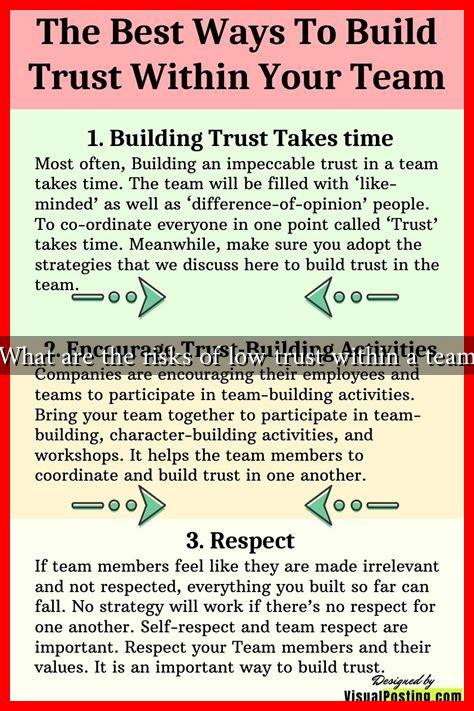-
Table of Contents
The Risks of Low Trust Within a Team
Trust is the cornerstone of any successful team. When team members trust one another, collaboration flourishes, communication improves, and productivity soars. Conversely, low trust can lead to a myriad of issues that can cripple a team’s effectiveness. This article explores the risks associated with low trust within a team, providing insights into how it can affect performance, morale, and overall success.
Understanding Trust in Teams
Trust in a team context refers to the belief that team members will act in the best interest of the group. It encompasses reliability, openness, and a willingness to be vulnerable with one another. According to a study by the American Psychological Association, teams with high levels of trust are more likely to achieve their goals and maintain high morale.
The Consequences of Low Trust
Low trust can manifest in various ways, leading to significant risks for teams. Here are some of the most critical consequences:
- Poor Communication: When trust is lacking, team members may withhold information or fail to communicate openly. This can lead to misunderstandings and a lack of clarity regarding roles and responsibilities.
- Decreased Collaboration: Teams that lack trust often struggle to collaborate effectively. Members may be reluctant to share ideas or seek help from one another, stifling innovation and problem-solving.
- Increased Conflict: Low trust can lead to heightened tensions and conflicts among team members. Disagreements may escalate quickly, resulting in a toxic work environment.
- Lower Morale: A lack of trust can lead to feelings of isolation and dissatisfaction among team members. This can result in decreased motivation and engagement, ultimately affecting productivity.
- High Turnover Rates: Teams with low trust often experience higher turnover rates. Employees may seek opportunities in more supportive environments, leading to increased recruitment and training costs.
Real-World Examples
Several organizations have faced challenges due to low trust within their teams. For instance, a case study involving a tech startup revealed that a lack of trust among developers led to missed deadlines and a failed product launch. Team members were hesitant to share their progress, resulting in duplicated efforts and wasted resources.
Another example can be found in the healthcare sector. A study published in the Journal of Healthcare Management highlighted that low trust among nursing staff led to communication breakdowns, which ultimately affected patient care. The study found that teams with higher trust levels reported fewer errors and better patient outcomes.
Statistics on Trust in Teams
Research indicates that trust is a critical factor in team performance. According to a survey conducted by Gallup, teams with high trust levels are 50% more productive and 76% more engaged than those with low trust. Furthermore, a report from the Institute for Corporate Productivity found that organizations with high trust levels experience 74% lower stress levels among employees.
Building Trust Within Teams
Addressing low trust within a team requires intentional effort. Here are some strategies to foster trust:
- Encourage Open Communication: Create an environment where team members feel safe to express their thoughts and concerns without fear of judgment.
- Promote Team-Building Activities: Engage in team-building exercises that encourage collaboration and relationship-building.
- Lead by Example: Leaders should model trustworthiness by being transparent, reliable, and accountable.
- Provide Constructive Feedback: Encourage a culture of feedback where team members can share insights and learn from one another.
- Recognize Contributions: Acknowledge and celebrate individual and team achievements to reinforce a sense of belonging and trust.
Conclusion
Low trust within a team poses significant risks that can hinder performance, morale, and overall success. By understanding the consequences of low trust and implementing strategies to foster a trusting environment, teams can enhance collaboration, communication, and productivity. As the saying goes, “Trust takes years to build, seconds to break, and forever to repair.” Investing in trust-building is essential for any team aiming for long-term success.
For further reading on the importance of trust in teams, consider exploring resources from the American Psychological Association and the Gallup Organization.


